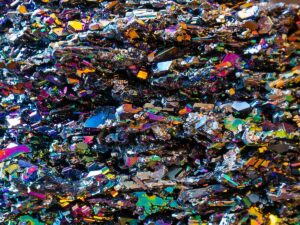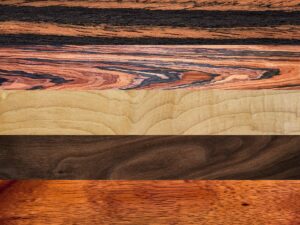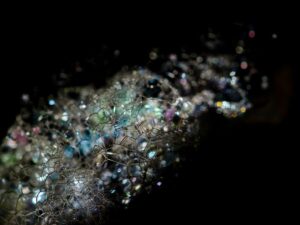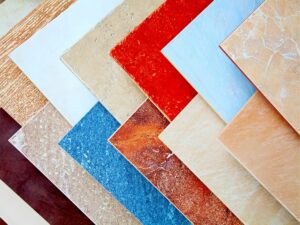At the heart of every exquisite ring lies a story of its material and craftsmanship. This article unravels the question business owners have wondered, what are rings made out of?
Embark on this illuminating journey, to gain a newfound appreciation for the art behind every ring. Keep reading to discover the intricacies of each material and the stories they tell.
1. Traditional Material
When discussing the artistry behind rings, traditional materials have always held a significant place. These materials blend the essence of history with timeless allure, crafting pieces that hold immense value. Some common traditional materials include:

Gold
Gold remains unparalleled in its historical and cultural significance. Renowned for its radiant glow, gold offers ease in molding, making it a jeweler’s favorite. Depending on the desired purity and strength, there are options like 24k, 18k, 14k, and 10k. Its resistance to tarnish has made it a go-to choice for timeless jewelry. In my journey, the elegance of 18k gold rings has always resonated well with wholesalers.
Silver
Silver’s charm lies in its gleaming, mirror-like finish. Most often, rings utilize sterling silver, comprising 92.5% silver, for added resilience. This metal, with age, can develop a patina, presenting an antiqued look, which many find sophisticated. A tad softer than some metals, it demands care to prevent undue scratches. A silver ring with intricate engravings can be a testimony to its malleability and sheen.
Platinum
A symbol of luxury, platinum stands out with its dense constitution. It often carries a heftier price tag than gold, a testament to its scarcity. Apart from being hypoallergenic, this metal is resistant to wear and tarnish, maintaining its silvery luster for lifetimes. Its strength is evident, but it can accrue minor surface scratches, which, interestingly, do not result in material loss.
Palladium
Palladium, belonging to the platinum family, offers a lighter touch and a radiant white gleam. Recognized for its resistance to corrosion, it’s a choice material for those valuing longevity without compromise on aesthetics. Its attributes often liken it to platinum, though it’s available at a slightly lower price range, marking its increasing popularity.
Copper
Beyond its familiar reddish-brown hue, copper often forms alloys to create variants like rose gold. The allure of copper rings is in their unique coloration, offering something distinct from the usual gold and silver. However, its propensity to tarnish necessitates periodic care. Alloys with copper, such as bronze, give an earthy, vintage aesthetic that’s been cherished in many cultures.
2. Alternative Metals
In the ever-evolving domain of jewelry, alternative metals have carved a niche for themselves. These metals deviate from tradition, bringing forth modern aesthetics and functionalities, enhancing the options for jewelers and buyers. Pioneering this transformation are the listed materials below:

Tungsten Carbide
Tungsten Carbide sets itself apart with unmatched hardness. While this makes it incredibly scratch-resistant, it’s worth noting its brittleness under substantial force. Its dense, weighty feel is often associated with a robust, masculine touch. The black and gray variants of tungsten rings have garnered attention, especially among contemporary jewelers.
Titanium
Lightness paired with formidable strength defines titanium. It naturally sports a cool gray shade, though alloying can introduce more colors. Being hypoallergenic, it becomes an evident choice for those wary of skin reactions. Throughout my career, I’ve marveled at how titanium blends strength with elegance, making it a favorite among many distributors.
Stainless Steel
Stainless steel rings offer a balance of durability and affordability. The metal’s resistance to tarnish ensures longevity, complementing its sleek modern look. For example, a stainless steel band with a minimalist design showcases the metal’s brilliance and simplicity. Moreover, variations like surgical steel amplify its hypoallergenic credentials, widening its appeal among various demographics.
Cobalt
Mimicking the luster of platinum, cobalt offers a radiant white gleam at a fraction of the cost. This alternative metal is moderately scratch-resistant, holding its own against daily wear. Its consistent coloration, unaffected by time, ensures a lasting sheen, making it a sought-after material in contemporary ring designs. Having worked with various materials over the years, cobalt has always impressed me with its timeless glow.
Rhodium
Rhodium, a member of the platinum group, is prized for its reflective white surface. Often used as a plating for other metals, it enhances resistance to scratches and tarnish. Although not commonly used in its solid form for rings due to its cost, its plating application on silver and white gold rings ensures a long-lasting shine and protection against wear.
3. Gemstones
The world of rings is not limited to metals; gemstones add the sparkle and allure that catches the eye instantly. These gems, derived from the heart of the earth, bring a myriad of colors, durability, and meanings, making rings unique and symbolic. From the fiery depths of Rubies to the serene blues of Sapphires, let’s delve into the diverse realm of gemstones:
Diamonds
Diamonds, often termed as a best friend to many, are the epitome of luxury and desire. With their unparalleled hardness and brilliant sparkle, diamonds symbolize eternity. Their formation under immense pressure over millions of years is a testament to their endurance.
Often sought after for engagement rings, their cut, clarity, color, and carat are the four determining pillars of their value. During my time in the industry, the allure of a perfectly cut diamond has always been irrefutable.
Rubies
Rubies, characterized by their deep red hue, are a symbol of love and passion. They belong to the corundum family, the same as sapphires, and are just next to diamonds in terms of hardness. The vibrant red of a Burmese ruby, for instance, is highly coveted in the jewelry market. Their allure lies not just in their color but also in their rarity and the tales they carry.
Sapphires
Sapphires, another gem from the corundum family, are most famously known for their royal blue shade. However, sapphires span a range of colors, excluding red, from pink to yellow to even colorless. Their durability makes them a popular choice for daily wear rings, and they often sit beside diamonds as symbols of loyalty and trust.

Emeralds
Emeralds, with their rich green tones, evoke images of spring and renewal. These gems, though softer than diamonds and sapphires, have a distinct appeal because of their unique inclusions, termed as the ‘gardens’. Proper care ensures their longevity, and their inherent elegance makes them a favorite in both vintage and modern ring designs.
Pearls
While pearls might not be the conventional ‘stone’, their organic beauty is undeniable. Born from the depths of the ocean within oysters, pearls have a soft luster and a timeless charm. Rexjewel understands this charm and has crafted a range of pearl rings that showcase their pristine beauty. They might require a bit more care to prevent scratches, but their unmatched elegance ensures they remain a classic in ring designs.
4. Wood
The integration of wood in ring designs showcases the amalgamation of nature and artistry. Bringing an earthy, organic feel to jewelry, wooden rings are distinctive and eco-friendly. While unconventional, these rings have carved a niche for themselves. The variety of woods used only adds to their individuality. Here are some common types of wood, along with their notable properties:

Ebony
Ebony, known for its deep black color, provides a stark contrast when paired with metals. Its dense nature ensures durability, making it a popular choice for wooden rings. Often sourced from Africa, ebony’s rich color is often used in combination with lighter woods or inlays for a striking visual effect.
Rosewood
Rosewood, as the name suggests, has a reddish hue, which deepens over time. Its aromatic nature is an added advantage, providing a sensory experience. Originating mainly from Brazil, its vibrant color and unique grain patterns make each ring distinct. I’ve always been drawn to the warm, rich tones of rosewood in ring designs.
Maple
Maple, characterized by its light color, offers a neutral backdrop perfect for inlays and combinations. Its durability, combined with its subtle grain patterns, makes it a favorite for those seeking a minimalist, natural look. Maple rings often feature colorful inlays, making them unique and personalized.
Walnut
Walnut, with its rich brown tones, carries a sense of depth and warmth. Its grain patterns are more pronounced, giving every ring a one-of-a-kind look. I’ve always been enamored by the unique personality walnut brings to each piece. Due to its moderate hardness, it’s often combined with other woods or materials to enhance durability.
Koa
Koa, native to Hawaii, brings with it tales of the islands and the vast ocean. Its colors range from golden brown to deep mahogany, with a shimmering quality called ‘chatoyancy’. This wood is not just beautiful but also symbolic, representing integrity and strength in Hawaiian culture.
5. Bones and Ivory
The jewelry industry has a history that meanders through the raw beauty of nature. Bones and ivory, remnants of the living, have been fashioned into ornamental pieces for millennia. Their organic origin lends an authentic touch to rings, connecting the wearer to the very essence of life. Delving into this ancient craft reveals several key materials, such as:

Animal Bone
Animal bones, often by-products from other industries, find renewed purpose in jewelry. Their natural textures and subtle colors provide a rustic charm to rings. The crafting process often involves carving, polishing, and combining with other materials for added appeal.
JUst like how a deer antler became a popular bone material with a rich history in indigenous jewelry. I’ve always admired the sustainability factor of using animal bones, giving them a second life in art.
Ivory
Ivory, primarily from elephant tusks, has a storied past. Historically treasured for its smooth texture and inherent luxury, it’s been sought after for ornamental use. However, ethical concerns over elephant poaching have led to a decline in its use and trade regulations. Repurposed ivory, from old piano keys or antique pieces, sometimes surfaces in jewelry to preserve its history without further harm to the ecosystem.
Mammoth Ivory
As an ethical alternative to elephant ivory, mammoth ivory emerges as a frontrunner. Extracted from the frozen tundras, this prehistoric material tells tales of a time long past. Its rarity, combined with its striking resemblance to elephant ivory, makes it a valuable resource for ring-making. Mammoth ivory, due to its age, often displays intricate patterns and colors, adding depth to jewelry pieces.
Bone Inlay
Bone inlay involves embedding finely crafted bone pieces into other materials. This technique brings about an intricate design and texture, enhancing the overall look of the ring. The contrast achieved, especially when set against dark woods or metals, is truly mesmerizing.
Carved Bone
Carving stands as one of the oldest methods of turning bone into art. Delicate patterns, symbols, or even faces can be etched onto the surface. The depth and precision involved in such craftsmanship make these rings genuine conversation starters. Every time I behold a carved bone piece, I’m transported back to the ancient times of artisans.
6. Glass or Crystal
When light filters through the translucence of glass or crystal, a magical dance ensues. These materials, born from the sands of time, captivate with their shine and clarity. Rings fashioned from such substances are not just ornaments; they’re miniature spectacles of refracted brilliance. Let’s explore the various facets of this shimmering world:

Murano Glass
Hailing from the Venetian island of Murano, this glass is a symphony of color and technique. Known for its vivid hues and intricate patterns, Murano glass rings are miniature works of art. The ancient techniques, handed down through generations, ensure every piece is unique. A ring bearing swirls of ocean blue and gold speckles, encapsulates the spirit of the Mediterranean.
Swarovski Crystals
Synonymous with luxury, Swarovski crystals dazzle like no other. Precision cuts, coupled with high-quality materials, make these crystals a favored choice in high-end jewelry. Their brilliance and variety of colors offer endless design possibilities. Having worked with in this industry for a couple of decades, I have witnesses swarovski’s commitment to perfection that is truly commendable.
Stained Glass
Stained glass, often associated with grand cathedral windows, finds its way into the jewelry realm. When set in rings, the play of light and color becomes personal, turning every movement into a luminous display. Techniques involve setting pieces of colored glass together, sometimes combined with metal outlines, to create intricate designs.
Crystal Quartz
Crystal quartz, a natural mineral, has a pure and clear appearance. Known for its healing properties in the realm of gemology, it’s a versatile material for ring crafting. Its natural facets play with light in subtle ways, offering a gentle shimmer rather than a dazzling sparkle. Paired with metals, the juxtaposition of shine and clarity is truly elegant.
Glass Enamel
Glass enamel involves fusing powdered glass to a substrate, resulting in a smooth, durable coating. In ring design, this technique offers a vast palette of colors. The resultant surface is glossy and vibrant, turning rings into bold style statements. The art of enameling requires precision, ensuring the perfect melding of glass and metal at high temperatures.
7. Resin
Rings have evolved from merely traditional materials to contemporary mediums. Resin, a versatile organic or synthetic compound, has become a favorite in ring-making due to its unique properties. This material allows for innovative designs, capturing a blend of artistic flair and modernity. The following sections delve deeper into resin’s application in crafting rings, such as:
Resin Casting
One of the primary methods of creating resin rings is through casting. This process involves pouring liquid resin into molds to form desired shapes. According to James Co., resin casting produces a very strong final product and is done in a quick production time; it can be heavy and uses multiple materials to make both the mold and the resin.
Many artisans prefer this technique due to its simplicity and the clear finish it often yields. This method has opened the door for incorporating various inclusions like flowers, glitter, or even small artifacts into the rings.
Resin’s Durability
Resin rings are known for their durability. Unlike traditional materials that might tarnish or corrode, high-quality resin can last for years without losing its shine. As someone who’s worked closely with various materials, I am constantly impressed by resin’s resilience. Furthermore, they are resistant to some chemicals, ensuring longevity.
Color Possibilities with Resin
The color possibilities with resin are vast. Resin can be tinted with a wide array of pigments, allowing for a diverse spectrum of colors in ring designs. Whether one is aiming for transparent, translucent, or opaque finishes, resin delivers. Thus, it enables craftsmen to develop rings that can cater to various aesthetic preferences, be it vibrant hues or understated elegance.
Incorporating Inclusions
Perhaps one of the standout features of resin rings is the ability to embed different materials. These inclusions can range from dried flowers and semi-precious stones to metallic flakes. Such incorporations not only enhance the design but also bring a unique narrative to each piece. Every resin ring with inclusions becomes a personal canvas, reflecting an artist’s vision or a wearer’s personal story.
Here’s a table summarizing key points about incorporating inclusions in resin rings:
| Aspect |
Description |
| Creative Design Element |
Inclusions, like dried flowers and semi-precious stones, are a standout feature in resin ring designs. |
| Unique Aesthetic Appeal |
Inclusions enhance the design, adding visual interest and uniqueness to each resin ring. |
| Personal Narrative |
Every resin ring with inclusions becomes a personal canvas, reflecting an artist’s vision or wearer’s story. |
| Artistic Expression |
Inclusions allow artists to express creativity, making each piece a work of art. |
| Customization Potential |
The choice of inclusions offers customization options for customers, ensuring a personal touch. |
Resin’s Eco-Friendliness
Resin, especially bio-based types, aligns with the increasing demand for eco-friendly materials. Being sustainable and non-toxic, eco-resins present a green alternative in the jewelry industry. They ensure reduced carbon footprints and minimal environmental impact, making them a favorite among environmentally-conscious businesses.
8. Silicone
Silicone, a synthetic rubber-like material, has steadily carved a niche in the world of ring-making. Known for its durability, flexibility, and non-toxic properties, it’s become a choice material for many. The versatility of silicone allows for creative and innovative ring designs. Explore the distinctive aspects of silicone rings in the sections below:
Durability and Comfort
Silicone rings offer a blend of comfort and durability. They are resistant to heat, cold, and various chemicals, ensuring a long-lasting wear. Its soft and flexible nature allows for continuous use without causing any discomfort. Moreover, the non-porous nature of silicone makes it resistant to bacterial growth, ensuring hygiene. Businesses seeking durable, comfortable, and hygienic ring options often find silicone a perfect fit.
Safety Features
One of the standout features of silicone rings is their safety. In professions where wearing traditional metal rings can pose hazards, silicone becomes a viable alternative. These rings can easily break under pressure, preventing possible finger injuries. This breakaway feature has made silicone rings popular among those engaged in manual labor or active sports.
Aesthetic Appeal and Customization
Silicone is available in a multitude of colors, patterns, and styles. From vibrant shades to more muted tones, the choices are vast. This material can be molded into various textures and patterns, allowing for a plethora of design options. Having seen countless designs over the years, silicone never ceases to amaze with its adaptability.
Cost-Effective Production
Silicone rings stand out for their cost-effectiveness. The production process is relatively simpler and more economical than metals or precious stones. Such affordability does not compromise quality, making it a favorite among many businesses aiming to offer value-packed products to their clientele.
Eco-friendly Properties
In the current global scenario, the shift towards eco-friendly products is evident. Accoridng to MINDSETECO, Silicone is more environmentally friendly, made from silica that it does not break down into micro-plastics. Production of silicone rings has a lower carbon footprint compared to traditional metals. Being recyclable, they also contribute to reduced waste, appealing to environmentally conscious distributors and wholesalers.
9. Plastic and Acrylic
In the vast world of jewelry-making materials, plastic and acrylic often emerge as versatile options. Both these materials offer the dual advantage of malleability and affordability. Diving deeper, we can uncover the myriad ways in which plastic and acrylic have carved their niche in the realm of ring creation. Let’s delve deeper into these materials and their influence in the realm of ring-making:

Molded Plastic Rings
The process of molding allows for the creation of intricate and consistent designs in plastic rings. By pouring molten plastic into predefined molds, artisans can reproduce exact shapes and patterns with high precision. This ensures consistency in bulk production, making it advantageous for wholesalers. Having observed a molding session, the precision and efficiency were indeed commendable.
Colored Acrylic Designs
Acrylic’s ability to be tinted in various hues leads to a vibrant array of ring options. From translucent to opaque, the range of colors is expansive. Combined with techniques like marbling, the resulting rings can mirror the appearance of precious stones or artistic patterns, providing a cost-effective alternative for ring enthusiasts.
Laser Cut Acrylic Rings
The advent of laser technology in jewelry-making has revolutionized acrylic ring designs. With laser cutting, intricate patterns can be etched onto acrylic sheets with impeccable accuracy. This method is particularly beneficial for crafting custom or limited-edition pieces. Business recently showcased a collection of laser-cut acrylic rings, reflecting city skylines, which were quite the talk of the town.
Durability and Longevity
While plastic and acrylic may not match the durability of metals, they are resistant to rust and tarnish. This resistance means that with proper care, these rings can last a significant amount of time. They also don’t react with most everyday chemicals, making them relatively easy to maintain. Plastics and arylics’ wide range of colors and ability to embed other materials make it a favorite among designers looking for creativity.
Eco-Friendly Variants
With increasing environmental awareness, many manufacturers are turning to bioplastics or recycled plastics for ring production. These materials reduce the carbon footprint and appeal to businesses and consumers alike, who are conscious about sustainability. Such initiatives provide a greener alternative in the expansive ring market.
10. Ceramic
Ceramic rings, exuding an understated elegance, are making their mark in the contemporary jewelry scene. Being both durable and aesthetically pleasing, ceramic offers a unique blend of function and form. As we delve into the realm of ceramic rings, several facets come to the fore. Here are the following:

Zirconium Ceramic Rings
Zirconium ceramic is notable for its black, glossy finish. Its natural color is achieved through a heating process, ensuring the hue doesn’t fade over time. Besides the aesthetic appeal, zirconium ceramic is also hypoallergenic, making it suitable for those with sensitive skin. The juxtaposition of its dark tone against inlaid gemstones or metals often results in striking visual contrasts.
Ceramic Inlay Rings
These rings seamlessly combine the resilience of ceramics with the allure of other materials, such as metals or gemstones. These inlays involve embedding a strip or section of ceramic within the band, creating a harmonious contrast and enhancing the ring’s overall aesthetic. The fusion of materials also benefits from the durability of ceramics, ensuring a long-lasting, eye-catching piece.
Hand-Painted Ceramic Rings
The smooth surface of ceramic rings serves as a canvas for artisans. Hand-painted designs, whether abstract or representative, lend a personalized touch to each ring. During a visit to a local artisan’s workshop, the sheer artistry of hand-painted ceramic rings was truly awe-inspiring. This method provides a means for businesses to offer custom designs to their clientele.
Thermal Properties of Ceramic
Ceramic’s thermal properties make it a standout material for rings. Its high melting point ensures structural integrity, preventing deformities even under intense heat during the crafting process. This thermal stability ensures that ceramic rings retain their shape and design without succumbing to environmental temperature changes. This unique property, combined with its lightweight nature, makes ceramic rings ideal for daily wear.
Resistant to Scratches and Wear
Ceramic ranks high on the Mohs scale of hardness. This means that it’s resistant to scratches and daily wear and tear. Rexjewe’s dedication to quality means ceramic rings are designed with this in mind, promising both durability and timeless style. Such durability ensures that ceramic rings maintain their sheen and structure for extended periods, making them a sound investment for those looking for longevity in their jewelry pieces.
Dive Deeper Into Our Resources
Looking for more diverse product options? Browse through our handpicked selections:
For some insightful reads, we’ve curated a list of recommended articles just for you:
Still haven’t found what you’re looking for? Don’t hesitate to contact us. We’re available around the clock to assist you.
Conclusion
The intricate dance of craft and composition in ring-making is a testament to human creativity, with each material chosen adding layers of meaning and aesthetic appeal. The choice of materials not only dictates the look and feel of a ring but also its story, significance, and longevity.
For those passionate about infusing artistry with top-tier materials, Rexjewel is your go-to jewelry manufacturer, seamlessly merging tradition with innovation. To explore the epitome of fine craftsmanship, contact us today and let’s craft legends together.








